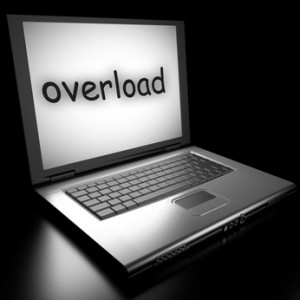 Our day sets us up for information overload. Social media, Magazines, T.V., Online Subscriptions, Newspapers, the list goes on. If we don’t learn how to regulate our information you can become overwhelmed. Your home and mind become cluttered. Business and home organizing suffer. We are far from the productive people we could be.
Our day sets us up for information overload. Social media, Magazines, T.V., Online Subscriptions, Newspapers, the list goes on. If we don’t learn how to regulate our information you can become overwhelmed. Your home and mind become cluttered. Business and home organizing suffer. We are far from the productive people we could be.
Here’s four simple steps to decrease your information and improve your home organizing, business organizing, and mental space:
Step 1 – Limit Times Checking Email
Harvard Business Review did a study on multi-tasking and time wasted on the psychological switching gears back and forth. Multi-tasking decreases your productivity by up to 50% and the switching back and forth between tasks or projects also wastes time of 10-45 minutes.
No wonder our to do lists are bulging, desks are piled high with unfinished paperwork, and people are drowning in email. Think about the business and home organizing you could get done with almost an entire hour added to your productive time.
Step 2 – Group like Activities Together
Depending on your type of work, set 2-5 times a day to check your email. Turn off all notifications and ringers.
For other activities like project work, making phone calls, responding to emails, meetings, coaching hours, service hours, invoicing, home organizing, and planning to name a few, block out times in your schedule to do similar tasks. This is also known as batching. Want to know where your times goes, track your activities for a week! It will be an eye-opening experience and you’ll get to the root issues of your productivity much faster.
Step 3 – Set boundaries
Get clear on your desired outcomes and goals and you’ll be more selective on what type of information you keep and let into your world. Create space by organizing your paper, books, magazines, photos and electronic files. Only keep what is useful, relevant and easy to access. Keeping something for “just in case I may need it someday” doesn’t cut it. This is where people get into overwhelm, waste time, procrastinate and create unnecessary piles of clutter in their offices, homes and computers. Home organizing suffers greatly!
Also, keep a small basket for magazines and reading material. When it’s full, its time to purge! When the filing cabinets are full, it’s time to purge and the same goes for bookshelves, your Inbox and other areas of your office and home.
Step 4 – Decrease Volume
When you know what your retention guidelines are for keeping computer files, financial files, project and paper files, meeting notebooks, emails, client files, magazine and newspaper subscriptions, and so on, deciding what to keep and what to purge is simple. You take the heavy thinking out of business and home organizing. Write out your retention policy for the different areas of your business or home office and have it handy on your computer for easy reference.
Recently, an Office Manager asked me what to do with 17 years of meeting notebooks. After discussing it for 30 minutes and talking with the Health Director, we were clear that all meeting minutes and financials were saved electronically and any other information that may be lingering in the notebooks were safe to let go. A week later, I received an email saying “I did it! I shredded 17 years of notebooks and I feel better. Out with the old, towards the future we go. The past is the past!” A huge load of stress was released, freed up some mental space for creative thinking, and space opened up in his office.
High performers practice the above steps because they are clear about where they are going, what information to let into their world and focus on doing the right actions on a consistent basis. Going on an information diet will free up physical space as well as space in your mind to be more creative and productive.
Want to improve business and home organizing? This is where it starts. What does your information diet include? Leave your comment below.